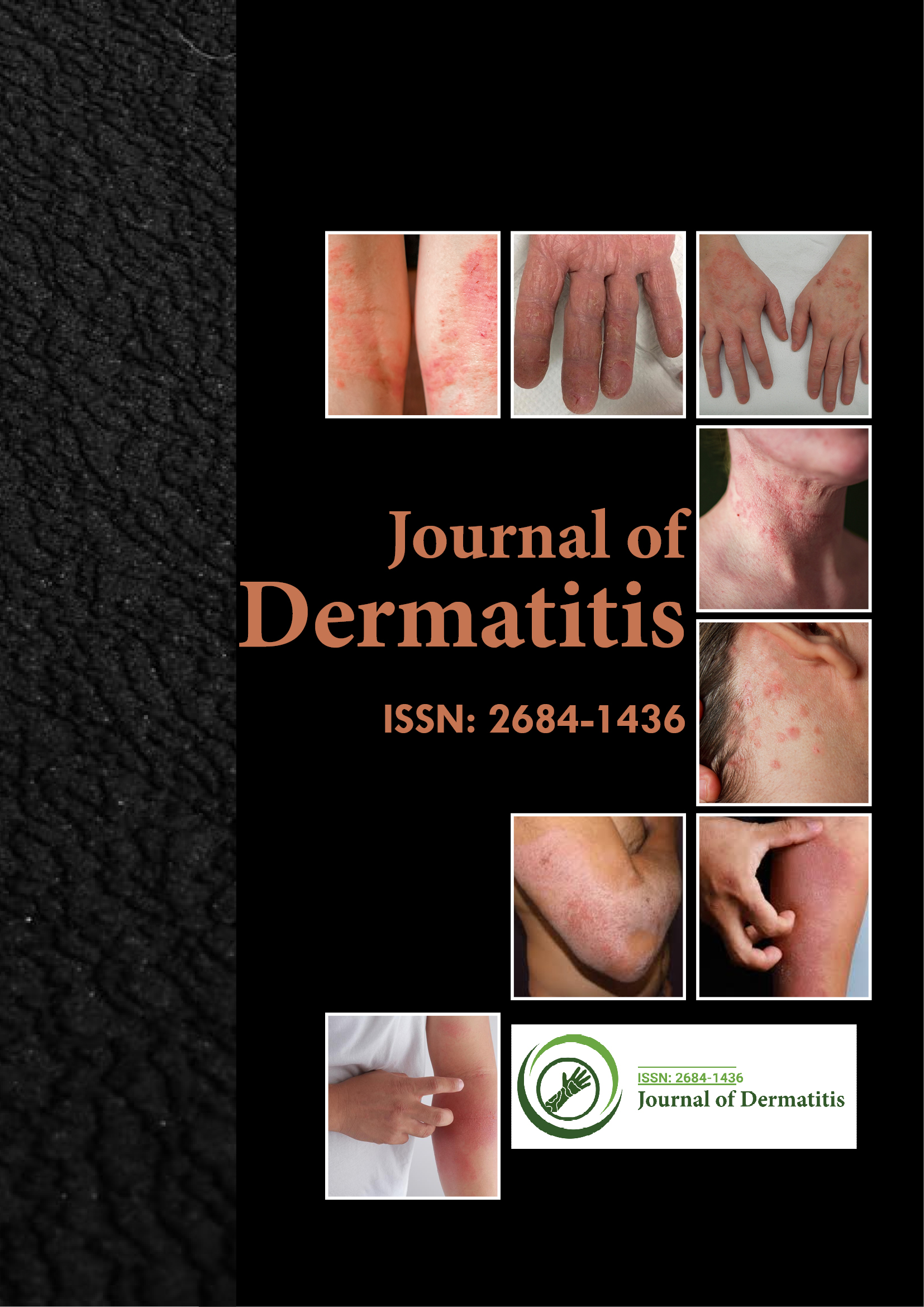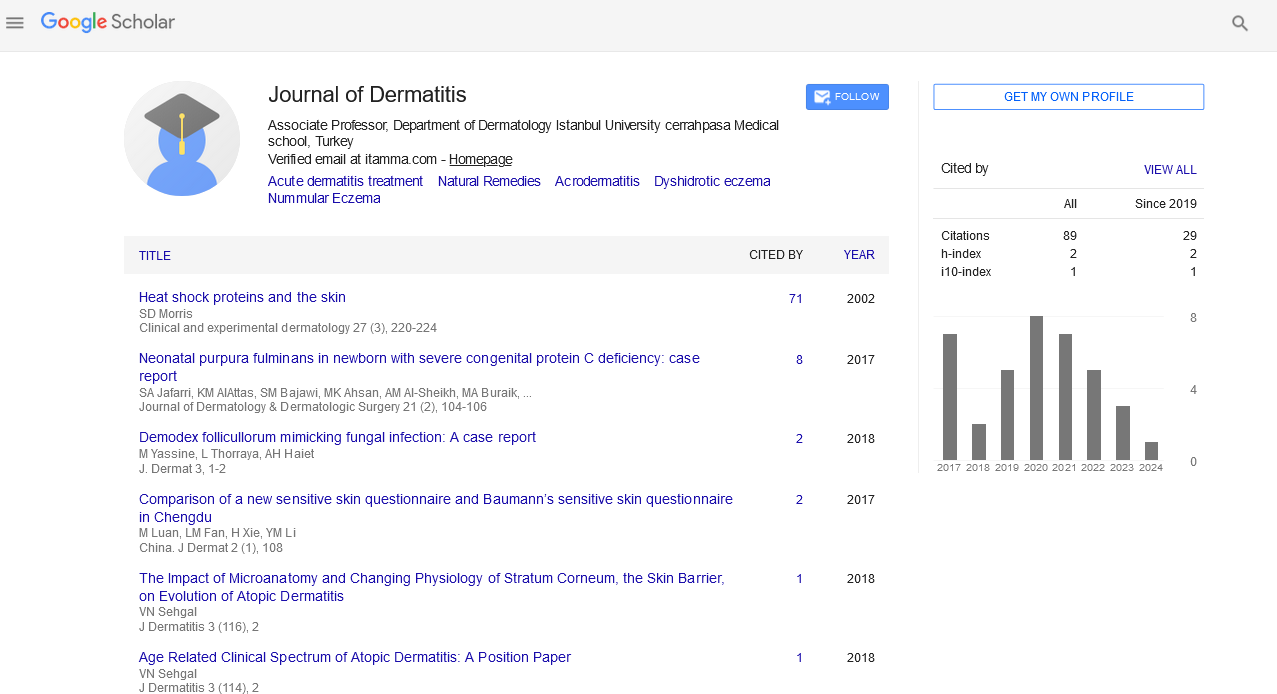Indexed In
- RefSeek
- Hamdard University
- EBSCO A-Z
- Euro Pub
- Google Scholar
Useful Links
Share This Page
Journal Flyer

Open Access Journals
- Agri and Aquaculture
- Biochemistry
- Bioinformatics & Systems Biology
- Business & Management
- Chemistry
- Clinical Sciences
- Engineering
- Food & Nutrition
- General Science
- Genetics & Molecular Biology
- Immunology & Microbiology
- Medical Sciences
- Neuroscience & Psychology
- Nursing & Health Care
- Pharmaceutical Sciences
Commentry - (2021) Volume 6, Issue 4
Drug-Induced Phototoxic Dermatitis
Qiang Wang*Received: 14-Jun-2021 Published: 05-Jul-2021, DOI: 10.35248/2684-1436.21.6.128
Description
Non-immunological, photochemical evoked provocative skin reaction in a lit area which takes after consume from the sun and may give erythema, oedema and bulla improvement. Photosensitizing substances increase the reactivity of the skin to UV radiation. They lead to extreme consume from the sun like skin reactions at radiation parcels which, with customary affectability of the skin, would be suffered without reaction. Photosensitizing substances can emerge endogenously (for example porphyrins) or can be provided exogenously by means of the skin (for example tar, eosin), gastrointestinal lot or parenterally (for example drugs). Medications causing phototoxic ejections incorporate antibiotic medications, phenothiazines, griseofulvin and dacarbazine. Effective Phototoxic Dermatitis is unintentional contact with or remedial utilization of a photosensitizer; trailed by UVA light (basically all effective photosensitizers have an activity range in the UVA range). Manifestations are hurting, stinging, and consuming instead of tingling. Recuperating ordinarily brings about articulated pigmentation. Here dim erythema is seen on the dorsum of the hands of a treated person with dimethyl chlortetracycline, which is utilized for skin inflammation. She had gone to a game and wore a cap that secured her head and neck; however she was clutching a rail, in this manner expanding the openness of her hands. There is, be that as it may, some erythema additionally on the scaffold of the nose and on the two cheeks. Phytophotodermatitis (plant light dermatitis) is an irritation of the skin brought about by contact with specific plants during sporting or word related openness to daylight. The incendiary reaction is a phototoxic response to photosensitizing synthetic compounds in a few plant families; a typical sort of PPD is because of openness to limes.
The patient had the oil from the skin of a lime on her fingers, which she then, at that point contacted to her face while sunbathing. Not to be mistaken for "Lyme" infection. You can become photosensitive from: Medications: Some generally utilized meds, including anti-toxins, nonsteroidal calming drugs (NSAIDS), antihistamines and certain heart prescriptions and statins for bringing down cholesterol, can make you undeniably touchier to daylight than you'd normally be. Sun-sharpening medications can likewise irritate existing skin conditions. Check this point by point rundown of prescriptions that have been associated with photosensitivity responses. Sicknesses and ailments: Certain ailments and problems, including immune system illnesses like lupus, can make you easily affected to UV beams. Check our report to see a rundown of infections and conditions that can cause photosensitivity. Healthy skin items: Certain fixings in items you use to make your skin look better, like retinols, glycolic corrosive or benzoyl peroxide, eliminate the furthest layer of skin to battle barely recognizable differences or skin inflammation. Brighteners like nutrient C may diminish the melanin in your skin, which goes about as a characteristic safeguard against the sun's beams. These may cause photosensitivity and increment your odds of harm from UV openness. Being tireless about sun assurance is critical while utilizing these items.
Treatment should separate between indicative treatment of showed polymorphous light ejection and counteraction. The first is basic as staying away from additional sun openness prompts quick and unconstrained reduction. It tends to be sped up by outside use of glucocorticoids. Antihistamines may reduce the pruritus yet their worth ought not be overestimated. The equivalent applies to effective antihistamines. Treatment alternatives include:
Avoidance of allergen and brief aversion of sun openness, including defensive apparel and wide range sunscreen, which don't contain the culpable specialist.
Cool splashes or potentially packs on a case by case basis.
Emollients on a case by case basis, including Vaseline or Aquaphor balms, calamine moisturizer.
Mid to high-strength effective corticosteroids two times every day depending on the situation.
Antihistamines on a case by case basis for tingle, for example Diphenhydramine (Benadryl) and Hydroxyzine (Atarax).
Anticipation is generally more significant. Light resilience or solidifying can be sped up utilizing phototherapy before the radiant time of the year. Absolute body radiation utilizing UVAn as well as UV-B is reasonable. Safeguard radiation ought to just be controlled under expert clinical oversight and not in a solarium to guarantee insignificant UV openness.
Photodermatoses are not dangerous but rather can cause significant anguish. Avoidance is similarly just about as significant as treatment.
Citation: Wang Q (2021) Drug-Induced Phototoxic Dermatitis. J Dermatitis. 6:128
Copyright: © 2021 Wang Q. This is an open-access article distributed under the terms of the Creative Commons Attribution License, which permits unrestricted use, distribution, and reproduction in any medium, provided the original author and source are credited.

